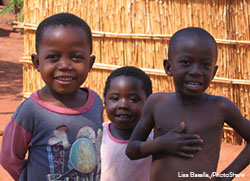 Approximately 10 percent of all newborns are born preterm each year. Preterm births account for an estimated 10 percent of all child deaths worldwide and are associated with growth failure, developmental problems, and many other adverse outcomes. Yet surprisingly little is known about the causes of preterm birth and its exact association with adverse health outcomes or about cost-effective prevention or management alternatives for low-income settings where the problem is most common. FANTA initiated a study with its partner, the University of Tampere, to investigate some of these issues through two databases collected as part of an earlier randomized clinical trial in Malawi known as the Lungwena Antenatal Intervention Study (LAIS) trial.
Approximately 10 percent of all newborns are born preterm each year. Preterm births account for an estimated 10 percent of all child deaths worldwide and are associated with growth failure, developmental problems, and many other adverse outcomes. Yet surprisingly little is known about the causes of preterm birth and its exact association with adverse health outcomes or about cost-effective prevention or management alternatives for low-income settings where the problem is most common. FANTA initiated a study with its partner, the University of Tampere, to investigate some of these issues through two databases collected as part of an earlier randomized clinical trial in Malawi known as the Lungwena Antenatal Intervention Study (LAIS) trial.
Results from the earlier LAIS trial had shown that women treated with monthly SP and two doses of AZI during pregnancy had an approximately 35% lower incidence of preterm delivery and babies with low birth weight than women in the control group who received only two doses of SP (12% vs. 18% for preterm delivery, 9% vs. 16% for low birth weight) (Luntamo et al. 2010). A similar positive effect was seen in the prevalence of neonatal stunting; 15% of the babies born to mothers in the intensive infection treatment group were stunted at 1 month of age compared to 24% in the control group (Luntamo et al. 2013).
The FANTA study analyzed the LAIS data to assess the medium-term impact that a prenatal intervention consisting of monthly doses of the antimalarial drug sulfadoxine-pyrimethamine (SP), with or without two doses of the antibiotic azithromycin (AZI), would have on childhood mortality, morbidity, growth, and development.
Results from the FANTA study show that differences in child length among children born to women treated with monthly SP and two doses of AZI during pregnancy were sustained during the first 5 years of life compared to children born to women who received only two doses of SP. It is also possible that differences in newborn weight and head size were sustained for 5 years among children born to women who received the intervention, but this was not conclusively confirmed. The results also support a positive effect of the intervention on post-neonatal infant mortality and the developmental status of the children at 5 years of age. The results do not, however, indicate that the intervention would reduce child morbidity during the first 3 years of life.
Noting that various child nutrition and health interventions implemented in different locations have had mixed results, the researchers also conducted a related study that found that participants’ residential location had some influence on the intervention results.


